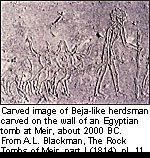Cranial remains [unspecified date, but guessing by some references to the burial site in that same area, it is perhaps dated to ca. A.D. 550-1450] of what appears to be a young female located Kulubnarti, Sudan, with its apparently well preserved braided hair locks. Braided hair locks is not an uncommon sight across continental Africa and the African diaspora even to this day.
Here is yet another example of a mummified specimen, but this one is identified with a name and more specifically dated, placed side by side with contemporary examples of braided hair locks/extensions...

Long braided hair locks of the types exemplified above are not the only the hairdos that invoke reminders of contemporary examples; the famous 'youth side-lock' [below: an artistic rendition of a young Rameses] too, can be located today...


Lest there are any assumptions that in the ancient Egyptian society, the 'side-lock of youth' was reserved for the royalty, one might want to give it a second thought, for we are told...
"As children grew, they apparently had carefree periods in their lives. There have been many toys and games found in excavations, and paintings showing children playing together. The children wrestled, raced, played tug of war, used small doll-like figures of animals, boats, balls, and danced, just like children do today. They had birds or dogs for pets. Very young children often went naked, or with girdles around their waists. Their hair was worn in a braided plait, with the end rolled up in a curl, the familiar "sidelock" of youth." - Marie Parsons, Childbirth and Children in Ancient Egypt
Why stop there; how about "fuzzy" dos?...the Beja warriors (compared below, with the figures on the stone carvings) were not mocked by intruding British adversaries as "Fuzzy Wuzzies" for nothing:
And then, well...the plain ol' Afro, as that sported by this ancient Egyptian male...
And so, the list of different examples may well go on and on...








